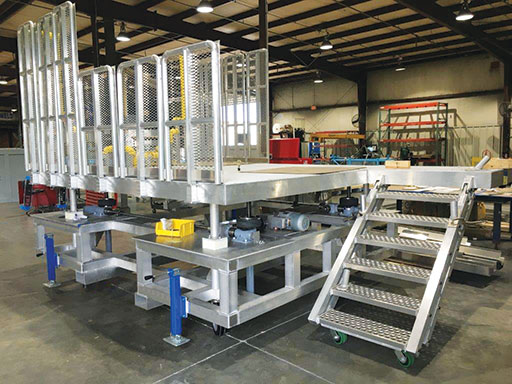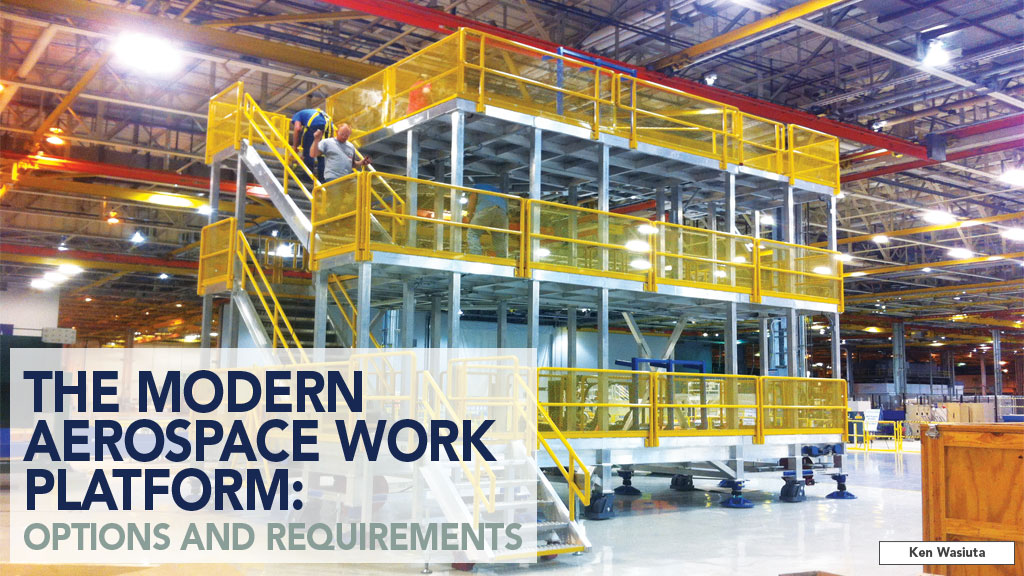Equipping maintenance personnel in the aerospace industry with the proper tools necessary to perform their required work safely and efficiently is critical. One of the most crucial tools that maintenance personnel need is a quality work platform that gets them very close to where they need to work. In the aerospace industry, this is often easier said than done. Thus, a reliable work platform is a key element that can sometimes be overlooked. Furthermore, the design and fabrication of work platforms involves many considerations and potential customizations that may not always be top of mind. Certainly, as the MRO industry has evolved, so have the demands on aerospace maintenance personnel as they pertain to the development and utilization of a work platform.
Work platforms are nothing new. Simple work platforms have been utilized in the industry for years. However, as technology has improved, so have the options available on work platforms. This evolution has led to the need for custom fabricators and designers to stay ahead of the demand and evolve along with the industry. There are features in today’s work platforms that simply weren’t available or even considered 20 years ago. What’s important to the industry today is much more advanced than ever before. In addition to more safety considerations, today’s aerospace maintenance worker prefers a work platform with improved mobility, configurability, worker access, utility availability and specific material selection. These elements all must be top of mind for designers and fabricators in order to deliver an efficient, effective platform.
Safety is typically the number one priority for maintenance workers. Therefore, first and foremost, a work platform must follow OSHA guidelines. Unfortunately, there are still work platforms in use today that do not meet the most current guidelines. This can be due to a variety of different reasons. For example, perhaps there are not sufficient handrails, or the incline on a certain set of stairs doesn’t satisfy the OSHA’s requirements concerning how steep they can be. There are countless elements that OSHA outlines pertaining to the safety of work platforms and designers and fabricators need to be confident that the equipment they are ultimately delivering meets these standards. Every single facet of the work platform must meet the guidelines. Not a single element can be overlooked.
Load rating is certainly one of the most important safety elements that must be considered when designing a reliable work platform. This starts with the designer having a good understanding of how the platform will be used, the number of people who might be on it at one time and any equipment that might be used on it, and then designing the work platform accordingly.
A development that has continued to gain momentum is the demand for non-slip walking surfaces. The safety implications associated with ensuring that walking surfaces have this characteristic cannot be overstated. To be clear, striving toward a non-slip walking surface is not new, but the technology has most certainly evolved over the years. Tread plate has been around for quite some time. This was one of the most common ways that this challenge was tackled. Tread plate, however, didn’t always protect against slips due to moisture or chemicals on the walking surface. There are a multitude of reasons why a work platform may get wet or oily. It could just be due to the nature of the work being done. Unfortunately, when these traditional surfaces get wet or oily, they could become extremely slippery. At that point, the non-slip aspects of the surface may as well not exist.
Today, there are options in the form of slip-resistant roll-on, spray-on and brush-on coatings. These have been known to perform better when moisture or oily substances are present. Additionally, there has been rising demand for using slip resistant engineered wood installed over corrugated metal decking. One particularly innovative solution involves the application of a metallic grit substrate directly onto a metal walking surface. It is an interesting process to apply this technology. A thermal spray containing the grit material is applied at a very high temperature to the walking surface material. When it cools, the non-slip characteristics develop. The most attractive element of this technology is its longevity. Unlike other grit materials added to surfaces that wear down and become less effective over time, this process surface holds up very well, even when exposed to moisture or oils.
Work platforms also cannot contain any components that might present hazards in the environment where they are used. For instance, if the platform will be used in an environment with explosive gases, such as in a paint booth, careful attention must be paid to the lights and other electrical devices on the platform that might create a spark and possibly an explosion.

Additionally, attention must be given to the material selected to build the platform. Depending on the environment the platform will be used in, only certain materials may be permitted. For example, chemicals may be present in a certain environment that will have a negative effect on a certain type of material. This degradation can ultimately compromise the integrity of the structure. Material selection also comes into play for platforms used in certain parts of the world, as locations near the ocean, which have high concentrations of salt in the air, or areas that are especially humid, can affect how a material performs over time.
Other elements that designers need to be aware of is the need for fall-restraint tie-off points for the various maintenance activities that will inevitably be performed that require this extra safety. Smaller but still critical features include the padding added to various points on the platform in the form of foam or rubber safeguards. These precautions are needed to protect both the items being maintained and the people maintaining them.
In addition to being safe, work platforms must be as practical and useful as the fabricators can possibly make them. This starts with mobility. In the past, even with mounted casters, work platforms were extremely difficult to move around. With improved technology, this is no longer the case. The caster industry has learned that by installing multiple wheels on a single caster, friction is greatly reduced, especially when getting a stationary caster rolling. Through these and other improvements, a single maintenance worker can more easily move by themselves what used to take multiple people to move.
In addition to easier movement, the industry today is looking for work platforms to be nimble. The platform must be designed to perform a variety of different tasks. Thus, the platform must have a robust configurability. It must be operable at different heights and accommodate any kind of unusual situation where a maintenance worker must get to a hard-to-reach area. This doesn’t just mean vertically, but horizontally as well. Slider decks and removable panels can be installed to achieve this goal.
Finally, there are many more options available in terms of utilities that can come with today’s maintenance platform, and fabricators need to be aware of the various demands that may come their way. Requirements may come in the form of hydraulic, pneumatic, compressed air or vacuum systems needing to be installed on the platforms. Are the electrical requirements going to be single, multiphase or low voltage? All could be a possibility. In the modern age of communication, data requirements must be considered. Enough data cables will need to be run to accommodate the number of computer workstations required.
Work platforms are anything but simple today and it’s important for fabricators and designers alike to keep a pulse on the growing demands from end-users in terms of safety and use.
Ken Wasiuta is the vice president of WB Industries, a custom metal fabrication company that builds and installs product solutions designed to improve safety, efficiency and performance. Many of WB Industries’ products are integral in local, national and international manufacturing facilities, military bases, aircraft carriers, public areas and within the country’s infrastructure. WB Industries applies customer specific requirements to its projects and work to several industry standards including NASA, Boeing, Lockheed Martin, AMS, AISC, IBC, ASTM and MIL specs.
